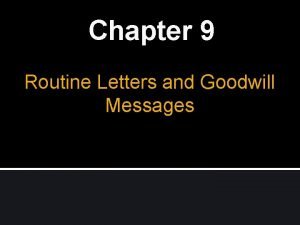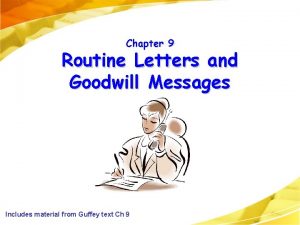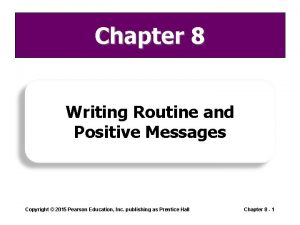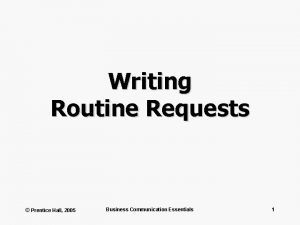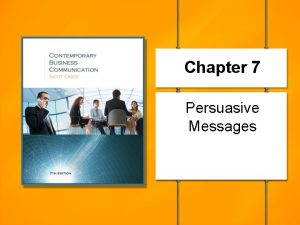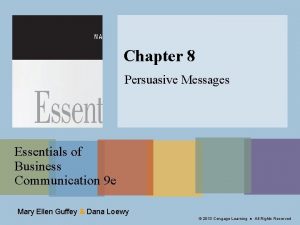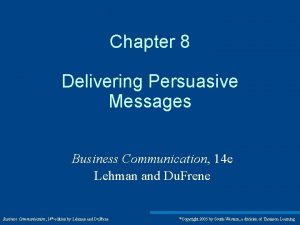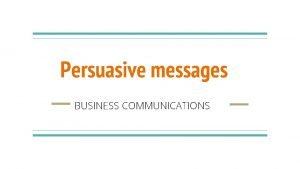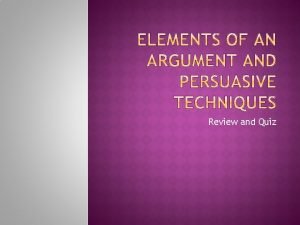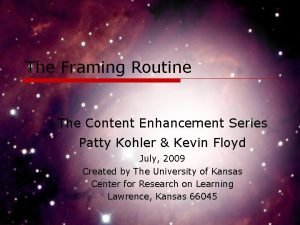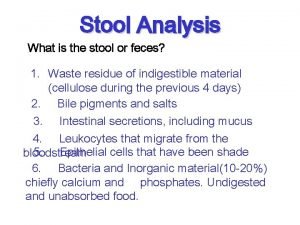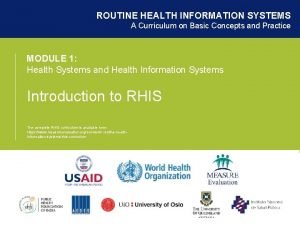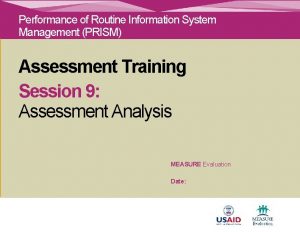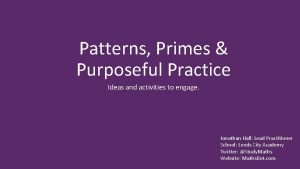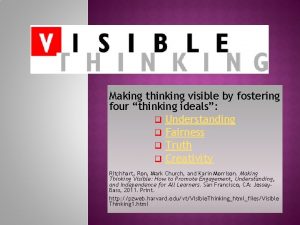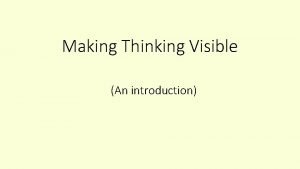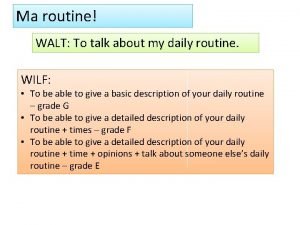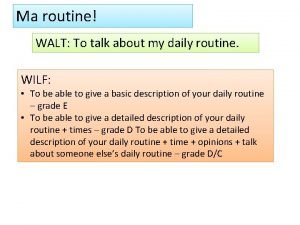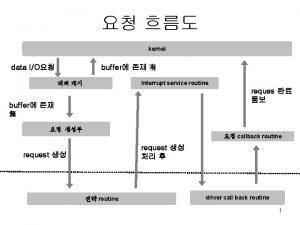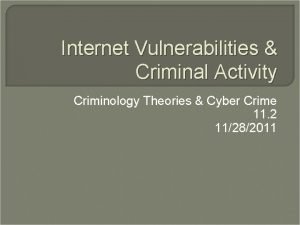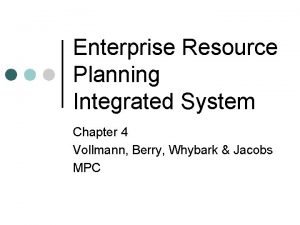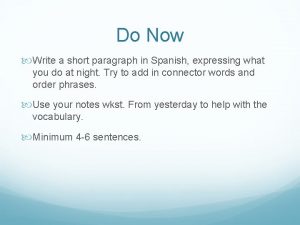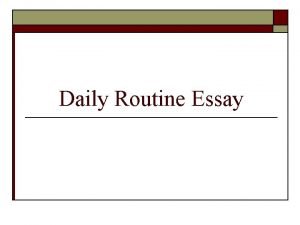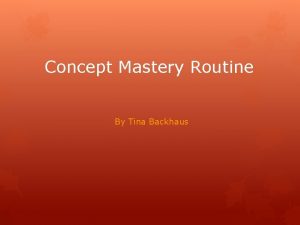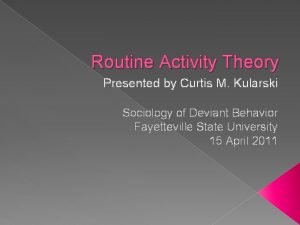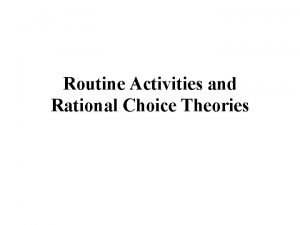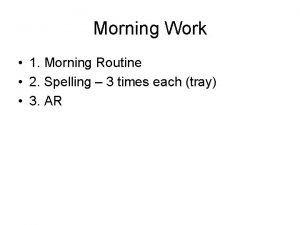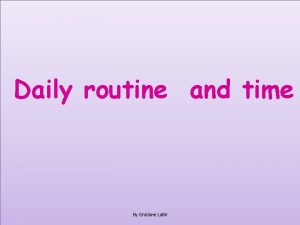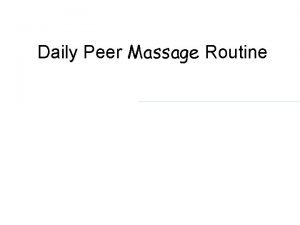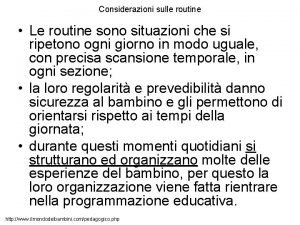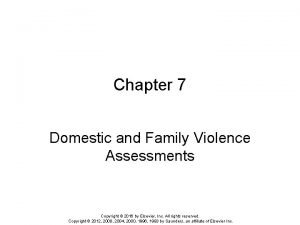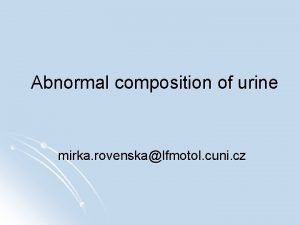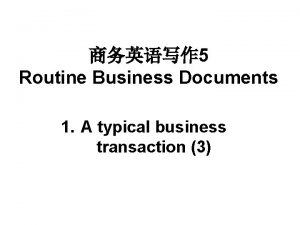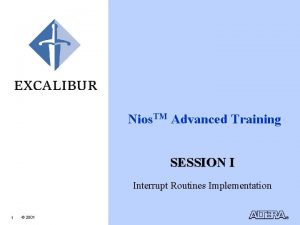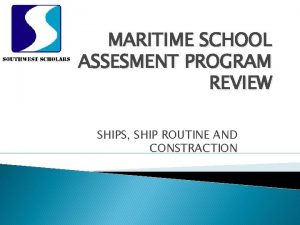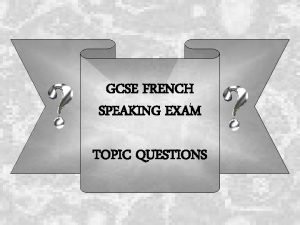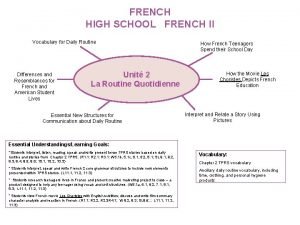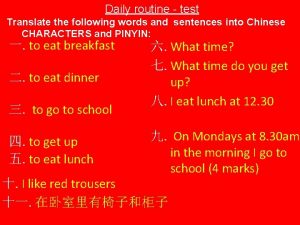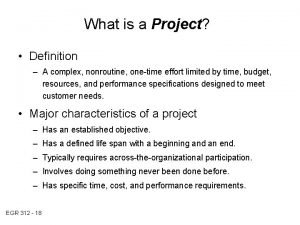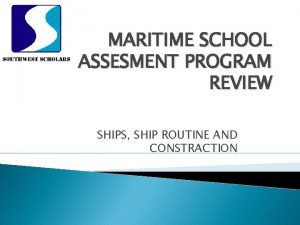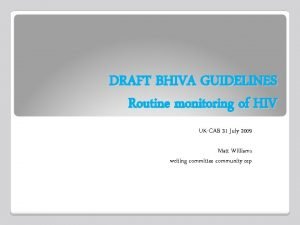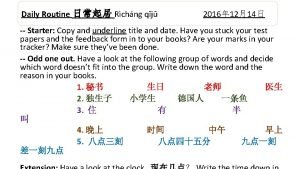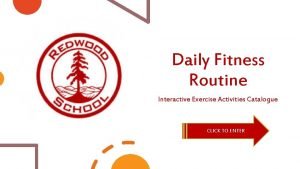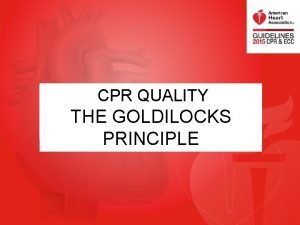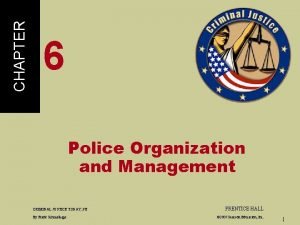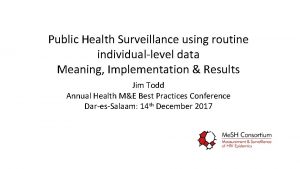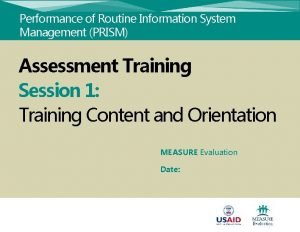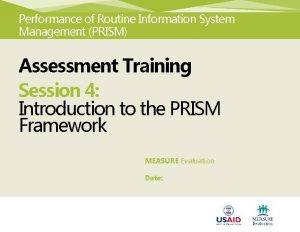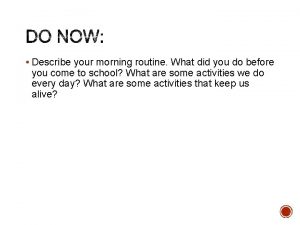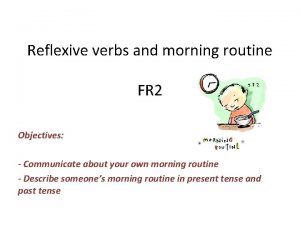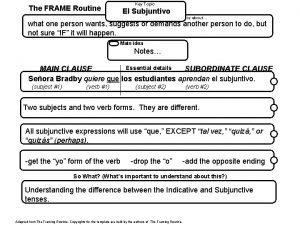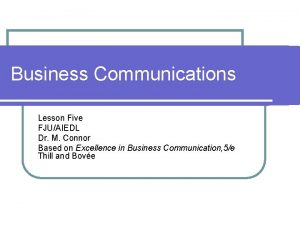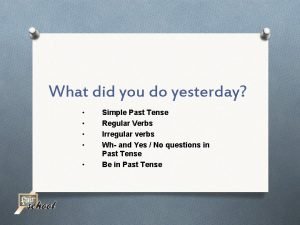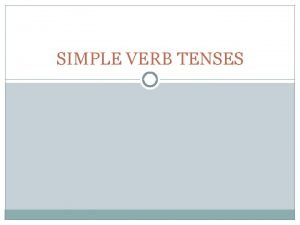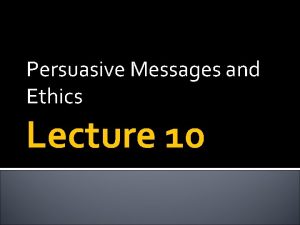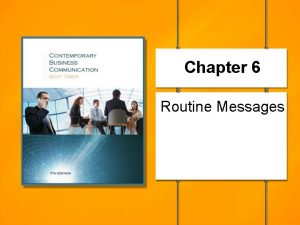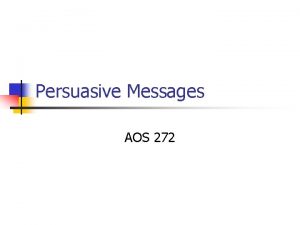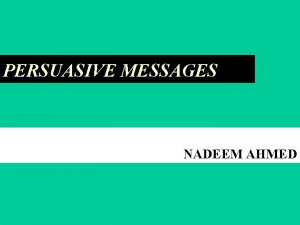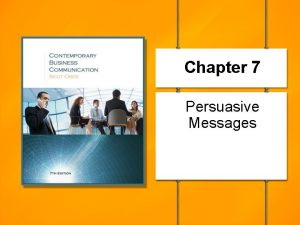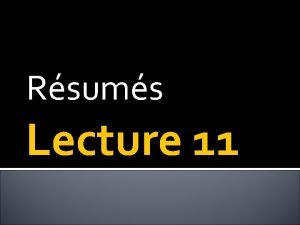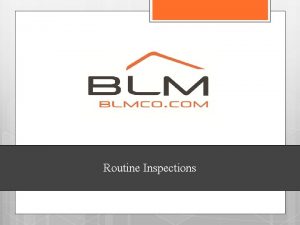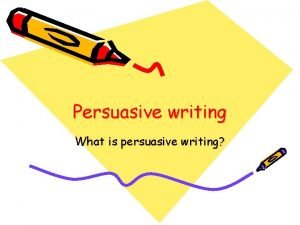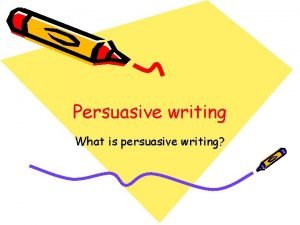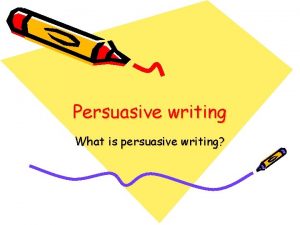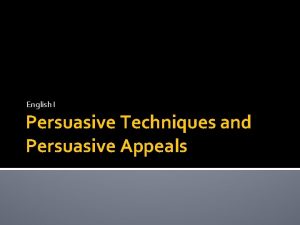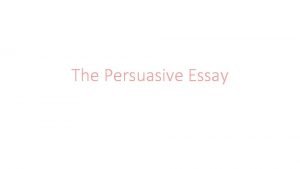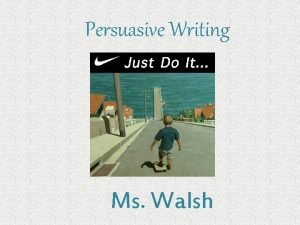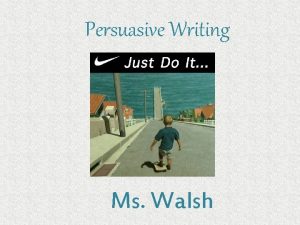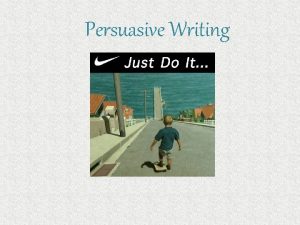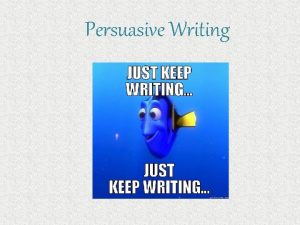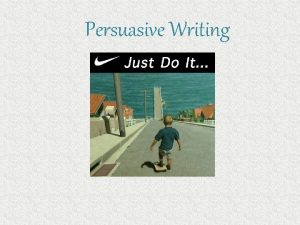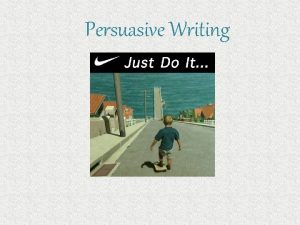Persuasive Messages Lecture 9 Yesterday Review Routine Messages



































































































- Slides: 99

Persuasive Messages Lecture 9

Yesterday Review Routine Messages Complaint Reference Request

Yesterday Bad News Messages 3 Step Writing Process Strategies Audience Centered Tone Direct/Indirect Approaches Types of Bad News Messages

Today Bad News Messages How to make a good subject line Cultural Difference – “I’m sorry”

Today Persuasive Messages 3 step writing process Strategies Review for Quiz

Neutral Subject Lines When using the indirect approach in an email, memo, or letter we must use a neutral subject line.

Neutral Subject Lines Our subject line must say what the message is about without saying any bad news

Neutral Subject Lines Bad subject lines Prices increase Schedule Delayed Lost Client Claim #2345 Denied

Neutral Subject Lines Good Subject Lines Prices Changed Schedule Revised Client Update Claim #2345

Neutral Subject Lines Good Subject Lines Prices Changed Schedule Revised Client Update Claim #2345

Neutral Subject Lines Use these with the indirect approach

Neutral Subject Lines For replies to messages and emails, simply hit “reply” in email

Neutral Subject Lines re: Invitation re: Meeting Schedule re: Job Application

I’m Sorry In English, saying “I’m sorry” does not mean you are apologizing We use it often

I’m Sorry Using “I’m sorry” in a bad news message is OK I’m sorry we cannot help I’m sorry to hear that I’m sorry to tell you

I’m Sorry This is not the same as apologizing!

I’m Sorry Apologizing It’s my fault I was wrong It was my mistake

Persuasive Messages Used to change an Audience’s beliefs, attitudes, and actions Present an argument that readers will agree with and support

Persuasive Messages Used when: We are trying to sell something Asking people to support an idea Asking for an increase in salary Asking your boss to use your ideas

Persuasive Messages Longer and more complicated than routine messages Require much more planning

3 Step Writing Process Planning Writing Completing

Planning Analyze your purpose Analyze your audience Establish Credibility Be ethical

Planning Purpose Difficult because: Audiences are busy There are competing requests

Planning For these reasons, purpose must be clear, necessary and appropriate for the written channel

Planning Audience Search for common ground Find points of agreement Show you can satisfy their needs

Planning Ask Who is my audience? What do they need? What do I want them to do? How might they resist? What other offers exist?

Planning Appeal to your audiences needs! Find out their age, gender, occupation, income, etc. Change your message around this info

Planning Credibility This is your capability for being believed because you’re reliable and worthy of confidence. Credibility = believability

Getting Credibilty Support your message with facts. Documents, statistics, research results Name your sources Where did this information come from? If audience respects your sources, this is very effective

Getting Credibilty Be an expert Clearly demonstrate your knowledge of the subject Establish common ground Highlight the beliefs that you share with the audience.

Getting Credibilty Be enthusiastic Be excited about your subject Be objective Show all sides of the issue to present fair arguments

Getting Credibilty Be trustworthy Earn audiences trust with honesty and dependability Have good intentions Keep audience’s interest at heart

Planning Be ethical To be ethical is to do things in an honest, moral way.

Planning Do not try to manipulate or trick your audience. Persuade your audience, but keep their needs at heart

3 Step Writing Process Planning Writing Completing

Writing Direct? Indirect? Based on audience’s reaction

Writing When to use Direct approach When audience is objective When a message is long When audience has little time

Writing Since the purpose is to convince or to change our audience’s mind, we should usually use: The Indirect Approach

3 Step Writing Process Planning Writing Completing

Completing Use the same techniques Edit for style, content, readability. Correct errors

Persuasive Strategies 4 strategies for successful persuasion Framing your argument Balancing your appeals Reinforcing your position Overcoming audience resistance

Persuasive Strategies 4 strategies for successful persuasion Framing your argument Balancing your appeals Reinforcing your position Overcoming audience resistance

Persuasive Strategies Framing your argument Similar to indirect approach, but even more involved. Use the AIDA approach

AIDA approach AIDA – 4 step argument Attention (Opening) Interest (Body) Desire (Body) Action (Closing)

AIDA approach Attention Begin persuasive messages with an attention getting statement that is: Personalized You oriented Straightforward Relevant

AIDA approach Interest Explain relevance of message Give more details

AIDA approach Desire Second part of your body Provide evidence Explain how change will help audience Answer possible questions in advance

AIDA approach Action Closing Suggest action for readers to take Repeat audience benefits Make action easy

AIDA approach Action Closing Suggest action for readers to take Repeat audience benefits Make action easy

AIDA approach Perfect for indirect messages Save main idea for action phase Can be used in direct messages Use main idea as attention getter

AIDA approach To be successful, narrow your focus Stick to one goal or objective One action we want the audience to perform

Quiz Review Tomorrow’s quiz will cover: Lecture 5: The Writing Process Lecture 6: Editing Lecture 7: Routine Messages Lecture 8: Bad News Messages Lecture 9: Persuasive Messages

Writing Business writing must be fast Channels: Quick Response: Use Email Large Decisions: Use a Business Report

Writing Business writing must be fast Channels: Quick Response: Use Email Large Decisions: Use a Business Report

Writing Reasons to write: Someone has asked you to You want a permanent record Good format for making mistakes You are the right person to write Don’t need audience feedback

Writing 3 Step Writing process 1. Planning – Gather, organize, focus 2. Writing – Drafting 3. Completing - Editing

Writing Gathering Outside sources – books, websites, interviews, etc. Inside sources – brainstorm, free write. Always take notes!

Writing Organizing Outline Mind Map Pyramid Shaped Chart

Writing Focusing Find main points Decide what you want people to get from your message

Writing Get ideas down during drafting stage Worry about technical issues later

Quiz Review Tomorrow’s quiz will cover: Lecture 5: The Writing Process Lecture 6: Editing Lecture 7: Routine Messages Lecture 8: Bad News Messages Lecture 9: Persuasive Messages

Editing “Audience Memory Curve” State important points at beginning or at end of message Don’t bury main points in the middle

Editing Direct: main idea at beginning Fast Saves time Audience Centered Indirect: main idea at end For bad news For persuasive messages

Editing Introduction – opening Builds Reader Interest Explains why you are writing Gives a preview Conclusion – closing What will I do next? What should you do next? Goodwill ending

Editing Content Readability Style

Content Print a copy Review Communication Strategies Have a friend read it Shorten the paper

Readability Avoid wordiness Good Paragraph Structure Use the active voice Use transition words

Readability Avoid wordiness Good Paragraph Structure Use the active voice Use transition words

Style Headings Parallel Stand alone Sense White Space Lists (ordered, unordered) Vary paragraph length Margins (ragged right) Font Size and type

Quiz Review Tomorrow’s quiz will cover: Lecture 5: The Writing Process Lecture 6: Editing Lecture 7: Routine Messages Lecture 8: Bad News Messages Lecture 9: Persuasive Messages

Letter format Date (on top of the page) Address (name of the person you are sending the message to) Salutation (Dear Mr. , Dear Mrs. ) Subject line (optional) Body Closing (include signature)

September 13 2009 James Smith President Coca Cola Company 123 Fake Street Springfield, IL, USA 16802 Dear Mr. Smith, Body. Body. Body. Body. Body. Sincerely, Keith Cochrane

Memo Format Memo/email To: From: Date: Subject:

Routine Messages Assume audience is positive or neutral Short, clear, uncomplicated About normal business situations Day to day activity

Routine Messages Assume audience is positive or neutral Short, clear, uncomplicated About normal business situations Day to day activity

Routine Messages Introduction – opening State request. Be specific Avoid personal intros Body Explain request. Show reader benefits. Ask questions Conclusion – Closing Repeat request (time, place, phone#) Goodwill Ending

Routine Messages Types Normal Requests Claims and Adjustments Request for a reference/recommendation

Normal Request Intro – What you want Body – Why you want it Closing – repeat request with specific times and places

Claims and Adjustments Intro – State Problem Body – State Reasons and details Closing – Request Action

Reference Request Intro Ask permission state job/position say how you know the person

Reference Request Body Resume your good qualities Closing Who to send letter to goodwill ending

Quiz Review Tomorrow’s quiz will cover: Lecture 5: The Writing Process Lecture 6: Editing Lecture 7: Routine Messages Lecture 8: Bad News Messages Lecture 9: Persuasive Messages

Strategies Present Bad News Have audience accept news Maintain good relationships Maintain a good image for your company Reduce future messages

Audience must: Understand the news Accept the news See news as fair Have positive thoughts about you Feel good about themselves

Direct Approach Intro: State bad news Body: Reasons for the decision; provide alternatives. Closing: Positive statement to maintain good relationship

Indirect Approach Intro Buffer Body Neutral explanation of reasons Clear statement of the bad news (body) Closing positive, friendly statement

Buffer A good buffer: Does not mislead the reader Is neutral Must be about the subject Is respectful Is short Is unapologetic

Types of Bad News Negative Answers to Routine Requests Negative Company News Negative Employment Messages

Types of Bad News Refusing favours, information, help Depends on how much you know audience

Types of Bad News Refusing claims Indirect

Types of Bad News Bad news about your company Direct? Indirect? Bad news about employment Direct? Indirect?

Quiz Review Tomorrow’s quiz will cover: Lecture 5: The Writing Process Lecture 6: Editing Lecture 7: Routine Messages Lecture 8: Bad News Messages Lecture 9: Persuasive Messages

Persuasive message Used when: We are trying to sell something Asking people to support an idea Asking for an increase in salary Asking your boss to use your ideas

Persuasive message Used when: We are trying to sell something Asking people to support an idea Asking for an increase in salary Asking your boss to use your ideas

Strategy Analyze your purpose Analyze your audience Establish Credibility Be ethical

Credibility This is your capability for being believed because you’re reliable and worthy of confidence. Credibility = believability

Credibility Use Facts Name sources Be an expert Find common ground Be enthusiastic Be honest

Ethics Be ethical To be ethical is to do things in an honest, moral way Do not try to trick your audience

AIDA approach AIDA – 4 step argument Attention (Opening) Interest (Body) Desire (Body) Action (Closing)
 The categories of routine replies and positive messages
The categories of routine replies and positive messages Goodwill messages
Goodwill messages The most effective goodwill messages
The most effective goodwill messages What are routine and goodwill messages?
What are routine and goodwill messages? Examples of goodwill messages
Examples of goodwill messages Routine positive messages examples
Routine positive messages examples Routine messages in business communication
Routine messages in business communication What is the definition of a business letter
What is the definition of a business letter Unlike routine claims, persuasive claims:
Unlike routine claims, persuasive claims: 01:640:244 lecture notes - lecture 15: plat, idah, farad
01:640:244 lecture notes - lecture 15: plat, idah, farad What is persuasive messages in business communication
What is persuasive messages in business communication 14. what are persuasive messages?
14. what are persuasive messages? Persuasive message in business communication
Persuasive message in business communication Short review examples
Short review examples Persuasive writing quiz
Persuasive writing quiz Chapter review motion part a vocabulary review answer key
Chapter review motion part a vocabulary review answer key Uncontrollable spending ap gov
Uncontrollable spending ap gov Nader amin-salehi
Nader amin-salehi Traditional and systematic review venn diagram
Traditional and systematic review venn diagram Narrative review vs systematic review
Narrative review vs systematic review Dimitri and linda are trying to learn a new routine
Dimitri and linda are trying to learn a new routine Ensurance
Ensurance Blood in stool colour
Blood in stool colour District level routine information system
District level routine information system Performance of routine information system management
Performance of routine information system management Kaprekar's routine
Kaprekar's routine Tug of war visible thinking
Tug of war visible thinking See think wonder thinking routine
See think wonder thinking routine Ma routine
Ma routine Ma journée essay
Ma journée essay Entamoeba histolytica cyst labeled
Entamoeba histolytica cyst labeled Generic_make_request
Generic_make_request Types of interrupts in microprocessor
Types of interrupts in microprocessor Routine activities theory
Routine activities theory Routine decision making
Routine decision making Short paragraph in spanish
Short paragraph in spanish Daily routine essay
Daily routine essay Routine activities theory
Routine activities theory Concept mastery routine
Concept mastery routine Routine activity theory definition
Routine activity theory definition Routine activity and rational choice
Routine activity and rational choice Nk words list
Nk words list The frame routine
The frame routine Routine practices example
Routine practices example Daily routine in arabic
Daily routine in arabic Peer massage routine
Peer massage routine Il valore educativo della routine
Il valore educativo della routine Back to my routine
Back to my routine Chapter 7 domestic and family violence assessment
Chapter 7 domestic and family violence assessment Routine examination of urine
Routine examination of urine Routine documents
Routine documents Pseudocode for daily routine
Pseudocode for daily routine Stumble meaning
Stumble meaning Nios tm
Nios tm My daily routine animado
My daily routine animado Ship ship routines and construction
Ship ship routines and construction Croakie now has a new routine
Croakie now has a new routine School routine in french
School routine in french Daily routine french vocabulary
Daily routine french vocabulary Daily routine essay in chinese
Daily routine essay in chinese Reading daily routine
Reading daily routine Non routine definition
Non routine definition Sap conversion routine
Sap conversion routine Horizontal and vertical micro instructions
Horizontal and vertical micro instructions Ship routine
Ship routine Perubahan rutin adalah
Perubahan rutin adalah My vision express
My vision express Routine data sources
Routine data sources My daily routine in present continuous tense
My daily routine in present continuous tense Lipdystrophy
Lipdystrophy Zǎofàn
Zǎofàn Daily life lunch
Daily life lunch Exercise catalogue
Exercise catalogue Coronary perfusion pressure
Coronary perfusion pressure Volumetric glassware and routine glassware
Volumetric glassware and routine glassware Volumetric glassware examples
Volumetric glassware examples Police organization and management
Police organization and management The frame routine
The frame routine 200 pushups
200 pushups Routine surveillance
Routine surveillance Performance of routine information system management
Performance of routine information system management Performance of routine information system management
Performance of routine information system management Ie register in 8051 microcontroller
Ie register in 8051 microcontroller Routine activity theory
Routine activity theory Describe your morning routine
Describe your morning routine Three reads routine
Three reads routine Et toi
Et toi The frame routine
The frame routine When making a routine request, you should
When making a routine request, you should Yesterday's homework
Yesterday's homework In model
In model You remember what you were doing at this time yesterday
You remember what you were doing at this time yesterday What were you doing at this time yesterday
What were you doing at this time yesterday We didn't swim yesterday afternoon in spanish
We didn't swim yesterday afternoon in spanish What did you do yesterday? put a ( ) or a ( ).
What did you do yesterday? put a ( ) or a ( ). We played tennis yesterday
We played tennis yesterday Stfc hate loud music
Stfc hate loud music Helen at school yesterday
Helen at school yesterday Sorry, i ______ hear you at the door. *
Sorry, i ______ hear you at the door. * I cycle home yesterday when a man
I cycle home yesterday when a man



